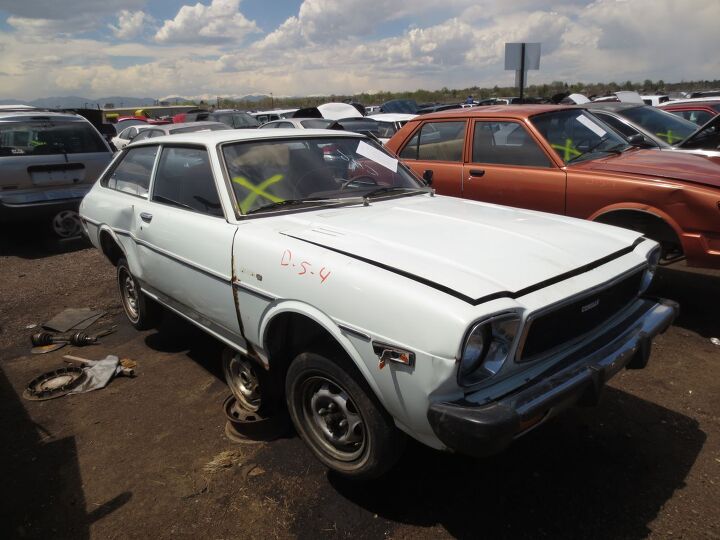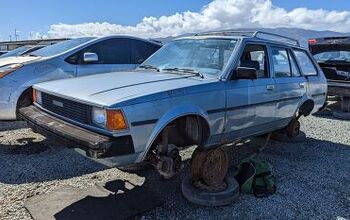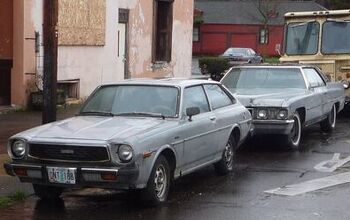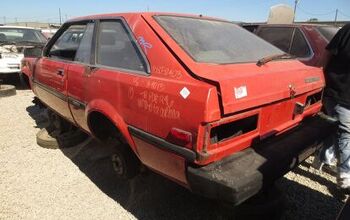Junkyard Find: 1976 Toyota Corolla Deluxe Liftback

Having driven quite a few mid-70s Corollas (these cars were as commonplace during my early driving years as are second-gen Tauruses today), I have to say that they were painfully slow even by the tolerant standards of the Middle Malaise Era. However, they were also shockingly reliable by the era’s standards, which means that these cars were still plentiful on the street until well into the 1990s. Since few outside a hard core of fanatics have shown much interest in pre-AE86 Corollas, these cars get scrapped as soon as something expensive breaks and/or the Rust Monster’s bites get too large. Here’s a Deluxe liftback that I found in a Colorado self-serve yard a few weeks back.
“A welded body, not a nuts-and-bolts body!”
This was the era of 5-digit odometers (I believe Toyota went to 6-digit units in the early 1980s), so there’s no telling if this is a 90,278-mile car or a 590,278-mile car.
The interior is in pretty good shape, so I’m guessing this car has no more than 190,278 miles on the clock.
While the 1976 Toyota subcompact version of “Deluxe” seems laughably Spartan today, this car did have some features you didn’t see on many cars in its cheapo price range.
Rear window defroster!
AM radio with slider-style tone and volume controls!
Most cars in Colorado don’t rust much, thanks to the area’s single-digit humidity, but Japanese cars of the 1970s were surpassed only by air-cooled Volkswagens in the “rust anywhere, rust everywhere” department.
It’s possible that this car spent much of its life in the Midwest, but this Colorado dealer emblem says otherwise.
The liftback hatch made these cars excellent haulers.
That is, they were excellent haulers if you didn’t have to move anything heavy… or carry passengers… or drive uphill. The pushrod 2TC was good for 75 horsepower, but it felt like less.
If you had one of these in your 2TC car, you needed plenty of patience when negotiating freeway onramps or attempting to pass a slow camper in the mountains. Still, these engines were hard to kill.

Murilee Martin is the pen name of Phil Greden, a writer who has lived in Minnesota, California, Georgia and (now) Colorado. He has toiled at copywriting, technical writing, junkmail writing, fiction writing and now automotive writing. He has owned many terrible vehicles and some good ones. He spends a great deal of time in self-service junkyards. These days, he writes for publications including Autoweek, Autoblog, Hagerty, The Truth About Cars and Capital One.
More by Murilee Martin
Latest Car Reviews
Read moreLatest Product Reviews
Read moreRecent Comments
- FreedMike Not surprisingly, I have some ideas. What Cadillac needs, I think, is a statement. They don’t really have an identity. They’re trying a statement car with the Celestiq, and while that’s the right idea, it has the wrong styling and a really wrong price tag. So, here’s a first step: instead of a sedan, do a huge, fast, capable and ridiculously smooth and quiet electric touring coupe. If you want an example of what I’m thinking of, check out the magnificent Rolls-Royce Spectre. But this Cadillac coupe would be uniquely American, it’d be named “Eldorado,” and it’d be a lot cheaper than the $450,000 Spectre – call it a buck twenty-five, with a range of bespoke options for prospective buyers that would make each one somewhat unique. Make it 220 inches long, on the same platform as the Celestiq, give it retro ‘60s styling (or you could do a ‘50s or ‘70s throwback, I suppose), and at least 700 horsepower, standard. Why electric? It’s the ultimate throwback to ‘60s powertrains: effortlessly fast, smooth, and quiet, but with a ton more horsepower. It’s the perfect drivetrain for a dignified touring coupe. In fact, I’d skip any mention of environmental responsibility in this car’s marketing – sell it on how it drives, period. How many would they sell? Not many. But the point of the exercise is to do something that will turn heads and show people what this brand can do. Second step: give the lineup a mix of electric and gas models, and make Cadillac gas engines bespoke to the brand. If they need to use generic GM engine designs, fine – take those engines and massage them thoroughly into something special to Cadillac, with specific tuning and output. No Cadillac should leave the factory with an engine straight out of a Malibu or a four-banger Silverado. Third step: a complete line-wide interior redo. Stop the cheapness that’s all over the current sedans and crossovers. Just stop it. Use the Lyriq as a blueprint – it’s a big improvement over the current crop and a good first step. I’d also say Cadillac has a good blend of screen-controlled and switch-controlled user interfaces; don’t give into the haptic-touch and wall-to-wall screen thing. (On the subject of Caddy interiors – as much as I bag on the Celestiq, check out the interior on that thing. Wow.)Fourth step: Blackwing All The Things – some gas, others electric. And keep the electric/gas mix so buyers have a choice.Fifth step: be patient. That’s not easy, but if they’re doing a brand reset, it’ll take time.
- NJRide So if GM was serious about selling this why no updates for so long? Or make something truly unique instead of something that looked like a downmarket Altima?
- Kmars2009 I rented one last fall while visiting Ohio. Not a bad car...but not a great car either. I think it needs a new version. But CUVs are King... unfortunately!
- Ajla Remember when Cadillac introduced an entirely new V8 and proceeded to install it in only 800 cars before cancelling everything?
- Bouzouki Cadillac (aka GM!!) made so many mistakes over the past 40 years, right up to today, one could make a MBA course of it. Others have alluded to them, there is not enough room for me to recite them in a flowing, cohesive manner.Cadillac today is literally a tarted-up Chevrolet. They are nice cars, and the "aura" of the Cadillac name still works on several (mostly female) consumers who are not car enthusiasts.The CT4 and CT5 offer superlative ride and handling, and even performance--but, it is wrapped in sheet metal that (at least I think) looks awful, with (still) sub-par interiors. They are niche cars. They are the last gasp of the Alpha platform--which I have been told by people close to it, was meant to be a Pontiac "BMW 3-series". The bankruptcy killed Pontiac, but the Alpha had been mostly engineered, so it was "Cadillac-ized" with the new "edgy" CTS styling.Most Cadillacs sold are crossovers. The most profitable "Cadillac" is the Escalade (note that GM never jack up the name on THAT!).The question posed here is rather irrelevant. NO ONE has "a blank check", because GM (any company or corporation) does not have bottomless resources.Better styling, and superlative "performance" (by that, I mean being among the best in noise, harshness, handling, performance, reliablity, quality) would cost a lot of money.Post-bankruptcy GM actually tried. No one here mentioned GM's effort to do just that: the "Omega" platform, aka CT6.The (horribly misnamed) CT6 was actually a credible Mercedes/Lexus competitor. I'm sure it cost GM a fortune to develop (the platform was unique, not shared with any other car. The top-of-the-line ORIGINAL Blackwing V8 was also unique, expensive, and ultimately...very few were sold. All of this is a LOT of money).I used to know the sales numbers, and my sense was the CT6 sold about HALF the units GM projected. More importantly, it sold about half to two thirds the volume of the S-Class (which cost a lot more in 201x)Many of your fixed cost are predicated on volume. One way to improve your business case (if the right people want to get the Green Light) is to inflate your projected volumes. This lowers the unit cost for seats, mufflers, control arms, etc, and makes the vehicle more profitable--on paper.Suppliers tool up to make the number of parts the carmaker projects. However, if the volume is less than expected, the automaker has to make up the difference.So, unfortunately, not only was the CT6 an expensive car to build, but Cadillac's weak "brand equity" limited how much GM could charge (and these were still pricey cars in 2016-18, a "base" car was ).Other than the name, the "Omega" could have marked the starting point for Cadillac to once again be the standard of the world. Other than the awful name (Fleetwood, Elegante, Paramount, even ParAMOUR would be better), and offering the basest car with a FOUR cylinder turbo on the base car (incredibly moronic!), it was very good car and a CREDIBLE Mercedes S-Class/Lexus LS400 alternative. While I cannot know if the novel aluminum body was worth the cost (very expensive and complex to build), the bragging rights were legit--a LARGE car that was lighter, but had good body rigidity. No surprise, the interior was not the best, but the gap with the big boys was as close as GM has done in the luxury sphere.Mary Barra decided that profits today and tomorrow were more important than gambling on profits in 2025 and later. Having sunk a TON of money, and even done a mid-cycle enhancement, complete with the new Blackwing engine (which copied BMW with the twin turbos nestled in the "V"!), in fall 2018 GM announced it was discontinuing the car, and closing the assembly plant it was built in. (And so you know, building different platforms on the same line is very challenging and considerably less efficient in terms of capital and labor costs than the same platform, or better yet, the same model).So now, GM is anticipating that, as the car market "goes electric" (if you can call it that--more like the Federal Government and EU and even China PUSHING electric cars), they can make electric Cadillacs that are "prestige". The Cadillac Celestique is the opening salvo--$340,000. We will see how it works out.






















































Comments
Join the conversation
Ah, memories. My father bought a lightly-used '78 Corolla SR5 Lift-Back in 1979, I think. It was to replace the '73 Pinto my parents had when I was born. I grew up in that Toyota, Dad drove it from the time I was 3 until I was 14. It was a dark burgundy color with those same gunmetal wheels as in the commercial. His was a 5-speed with A/C. (It was purchased in Charleston, South Carolina.) We moved to Buffalo, NY in 1986, and by the early '90s the Corolla was rusting pretty bad. One day Dad was tinkering underneath and a piece of frame rail came off in his hand. He promptly sold the car for $300. We would see it around town for at least a year after that. He's still nostalgic about that car. If I could find one in restorable condition, I'd buy it for him in a minute.
Had a 75 Corolla wagon as my first car out of college. Sold for 5K new and I paid $2,500 for it with 100K on the engine and 120K on the car. In those days a 5yr old Japanese car with 100K on it would sell for 1/2 its original retail value. It was reasonably spritely with the stick. Nicely appointed if simple interior, dignified lines. An all-around honest car.